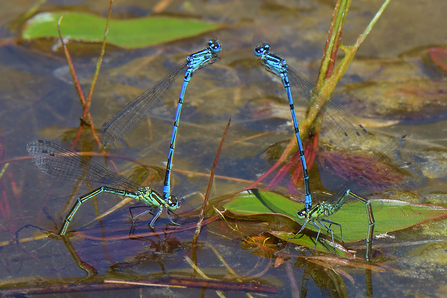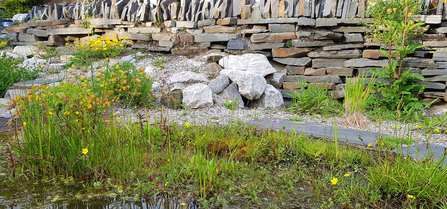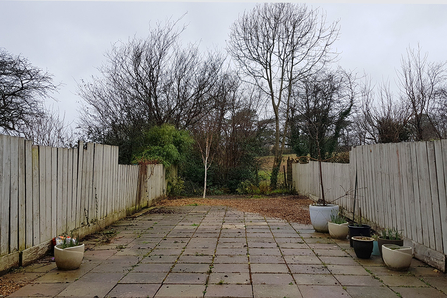Together the UK’s gardens make up more land than all the UK’s National Nature Reserves combined! With wildlife under threat every patch of land dedicated to nature has value. A passionate member, Hugh, from Swansea has been working tirelessly to provide a home for nature on his doorstep. During lockdown, Hugh enrolled his family in a project to take up paved slabs and install a wildlife haven in his back garden. His wildlife garden now includes a native wildflower patch, a pond a dry-stone wall and much more.
From Paving Slabs to Paradise
© Hugh Lansdown

Azure Damselflies mating on pond surface © Hugh Lansdown
When creating a wildlife garden, it is important to focus on three things. Shelter, food and water. Shelter provides a resting area, habitat for breeding, nesting or egg laying and protection from predators. Food can come in the form of vegetation or creating habitat for prey which provides a food source for predators. Finally, water, which can come in all forms large or small. For a pond we recommend nothing smaller than 30cm x 30cm. If you don't have enough space for this then a shallow dish of water will provide a bath for birds or a watering hole for bumblebees! For more tips and tricks on building a pond see here. Every little helps so whatever space you have to spare, do what you can!
Fox cubs in a team wilder garden (https://youtu.be/JBziVAWrw3o)
Fox cubs visiting the pond at night © Hugh Lansdown
Hugh has had a huge success in his garden with visits from young fox cubs caught frolicking around on a camera trap to breeding blue damselfies! He says the key to this is native plants.
"To get breeding butterflies I made sure to plant the correct food species for their caterpillars; such as birds-foot trefoil and kidney vetch for Common and Small blue and then alder buckthorn for Brimstone"
Hugh's garden not only features ponds and native plants but he has gone above and beyond to provide a variety of habitats ensuring diveristy in what is available. The garden includes a dry stone wall full of nooks and crannies for mosses and lichens as well as creating the perfect hibernation spot. Toads, frogs and slow-worms will hide in the damp crevices and newts will use the spot to hibernate during our colder months.
By placing log piles around the garden, shelter has been created for small mammals and inverterbrates. Hedgehogs and amphibians will visit the log pile, feasting on the critters tucked away in all it's crevices. Find out how to build a log pile here.

Pond with native aquatic plants in front of a dry stone wall © Hugh Lansdown
If you're thinking about turning your garden into a more wildlife freindly space then here are Hugh's five top tips:
- Plant genuine local, native plants.
- Avoid chemicals or power tools such as strimmers, hedge trimmers and mowers.
- Lower the nutrient levels by mixing sand and gravel into the soil before you start.
- Try to include a pond or water source, even the smallest pond is valuable for wildlife.
- Try to include some stones or logs to provide shelter from the elements and local cats.

Hugh's back garden before he began work to transform it ©Hugh Lansdown
From the picture above to a now complex habitat with aquatic and terrestrial ecosystems, Hugh's garden has drastically changed. Thanks to his and his family's efforts, it is now a thriving green space that holds great value to not only local wildlife but also for his enjoyment and well-being.
If you have a project you would like to share with us then please get in touch with Marianne at m.evans@welshwildlife.org as we wold love to hear your story.


